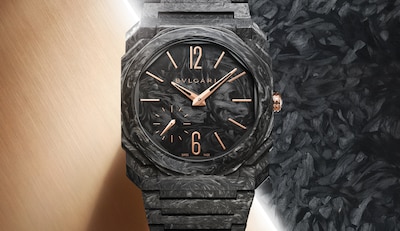In Conversation With Fabrizio Buonamassa Stigliani, Product Creation Executive Director at BVLGARI

BVLGARI‘s rise from watchmaker to broad spectrum horological colossus with a volume and range that only Cartier comes close to matching has been astonishing. And if a large part of that rise arrived through the simple act of acquiring the GGDR business some 20 years ago, it’s what BVLGARI built on the base of that foundation that really impresses, a story that’s retold in the newly published “Beyond Time” book and amply illustrated in the watch launches that BVLGARI is showing at this year’s Geneva Watch Days.
Beyond Time is the first authorised history of BVLGARI horology and charts a century of watchmaking beginning with jewellery watches in the 1920s but understandably gives greatest prominence to the Octo Finissimo, the multiple record-breaking ultra-slim design that has become the symbol of BVLGARI’s contemporary watchmaking. There’s now a full suite of complication movements, including both a tourbillon and a minute repeater and, with the most important movements all completed, attention has returned to the case material. Alongside the innovative gold finishes, BVLGARI have introduced materials such as titanium and ceramic, a technical offering that will now include carbon-fibre as seen in the new Octo Finissimo CarbonGold Automatic and Octo Finissimo CarbonGold Perpetual Calendar.
What the book doesn’t quite cover is the extraordinary level of trust that BVLGARI places in its teams, something that I discovered catching up with the ever affable and stylish Fabrizio Buonamassa Stigliani, BVLGARI’s design leader (officially he’s Product Creation Executive Director) for watches over much of the last two decades.
Talking about this year’s new Serpenti Misteriosi, Buonamassa said that he raised the idea of a mechanical movement for jewellery watches because, ‘quartz is fine, it’s what everyone uses but I felt that the collectors we gained from Octo Finissimo and our haute horlogerie watches were looking at us more closely and quartz doesn’t match the ambition of jewellery. We couldn’t use Jaeger-LeCoultre’s 101 because it’s the wrong shape for the Serpenti and we wanted better time-keeping than it can deliver.’ (The 101, after all dates back to the 1930’s).
As he was aware, there’s a reason that no-one had designed a new jewellery-watch size movement; the dimensions make a difference to how the materials work whether that’s a less stable balance or a shorter power reserve, but BVLGARI placed the team that produced the Finissimo movements onto the job and Buonamassa had the movement, named the Piccolissimo, that he needed to create a new leaner, sharper Serpenti. And, because the movement slots into the head, it means that he doesn’t have to worry about a mismatch between a head made in Switzerland and a body made in Italy. “Our problem is now deciding where to use the movements we will receive, we have too many possibilities.”
One project that demanded a Piccolissimo movement is the one of the most challenging projects Buonamassa has undertaken, the new Monete Catene Dual Time. Continuing a tradition where BVLGARI create jewellery around ancient coins, this watch features coins that mark the reign of the emperor, Septimus Severus and, almost uniquely, his empress Julia Domna - one of the few empresses to have wielded real power in her own name. The Monete Catene watches are naturally unique pieces as, after so many centuries, no two coins are quite alike.
Find out more about BVLGARI and shop online todayWhat the book doesn’t quite cover is the extraordinary level of trust that BVLGARI places in its teams, something that I discovered catching up with the ever affable and stylish Fabrizio Buonamassa Stigliani, BVLGARI’s design leader (officially he’s Product Creation Executive Director) for watches over much of the last two decades.
Talking about this year’s new Serpenti Misteriosi, Buonamassa said that he raised the idea of a mechanical movement for jewellery watches because, ‘quartz is fine, it’s what everyone uses but I felt that the collectors we gained from Octo Finissimo and our haute horlogerie watches were looking at us more closely and quartz doesn’t match the ambition of jewellery. We couldn’t use Jaeger-LeCoultre’s 101 because it’s the wrong shape for the Serpenti and we wanted better time-keeping than it can deliver.’ (The 101, after all dates back to the 1930’s).
As he was aware, there’s a reason that no-one had designed a new jewellery-watch size movement; the dimensions make a difference to how the materials work whether that’s a less stable balance or a shorter power reserve, but BVLGARI placed the team that produced the Finissimo movements onto the job and Buonamassa had the movement, named the Piccolissimo, that he needed to create a new leaner, sharper Serpenti. And, because the movement slots into the head, it means that he doesn’t have to worry about a mismatch between a head made in Switzerland and a body made in Italy. “Our problem is now deciding where to use the movements we will receive, we have too many possibilities.”
One project that demanded a Piccolissimo movement is the one of the most challenging projects Buonamassa has undertaken, the new Monete Catene Dual Time. Continuing a tradition where BVLGARI create jewellery around ancient coins, this watch features coins that mark the reign of the emperor, Septimus Severus and, almost uniquely, his empress Julia Domna - one of the few empresses to have wielded real power in her own name. The Monete Catene watches are naturally unique pieces as, after so many centuries, no two coins are quite alike.
Find out more about BVLGARI and shop online today